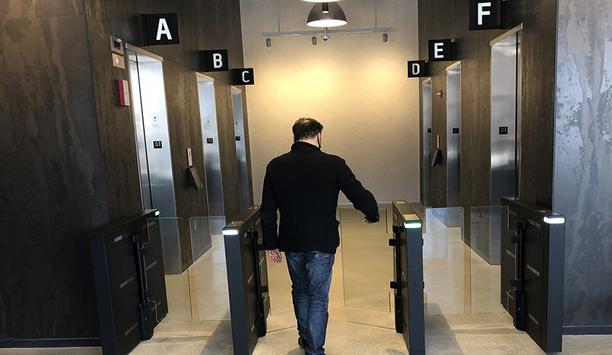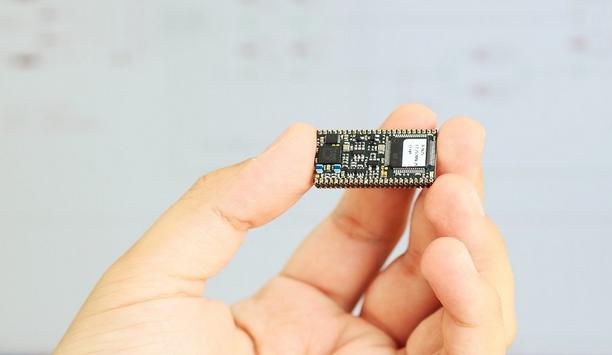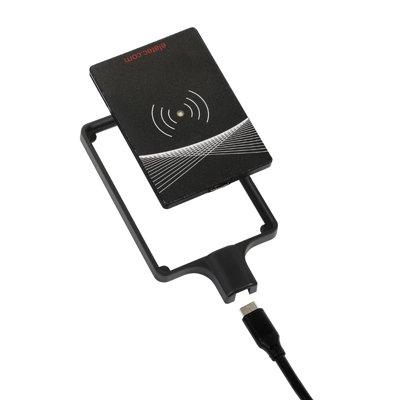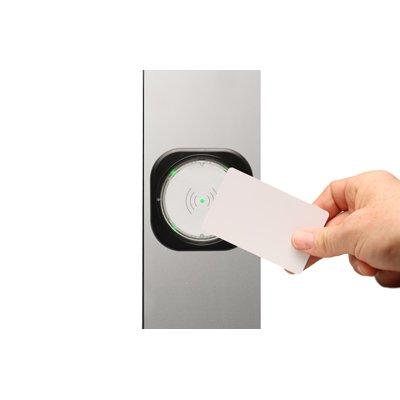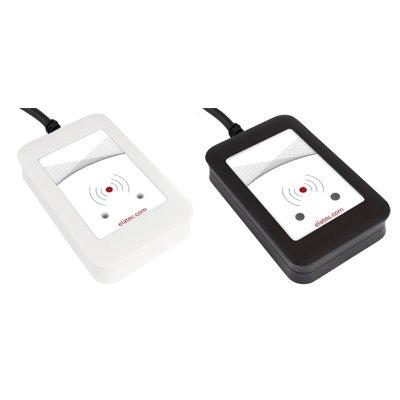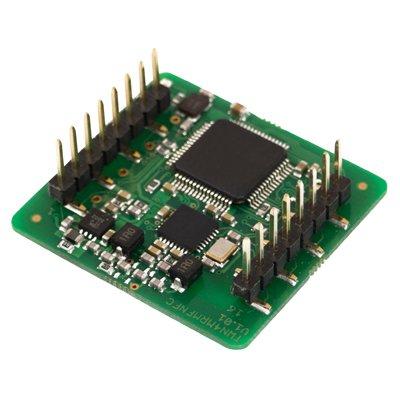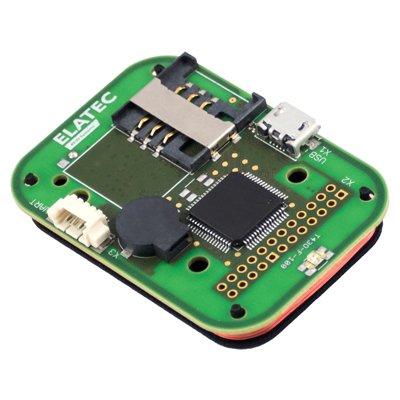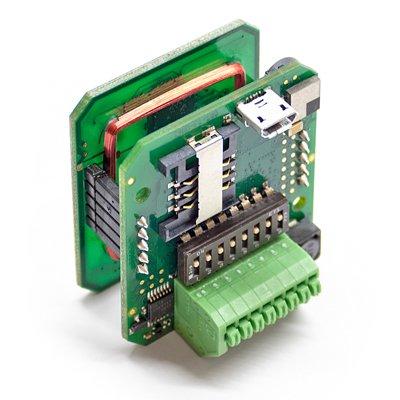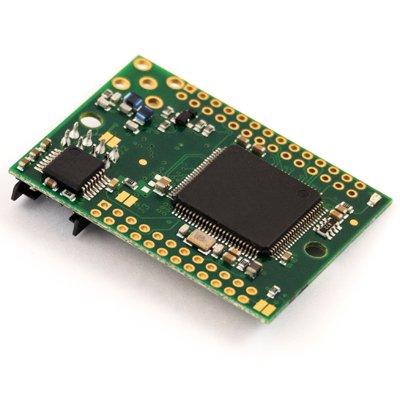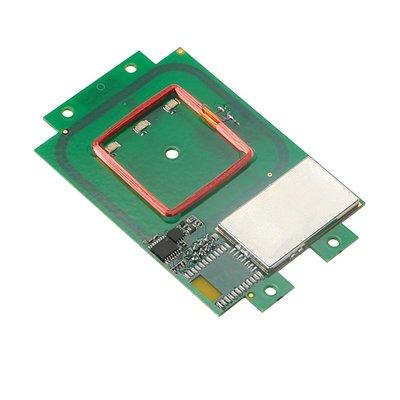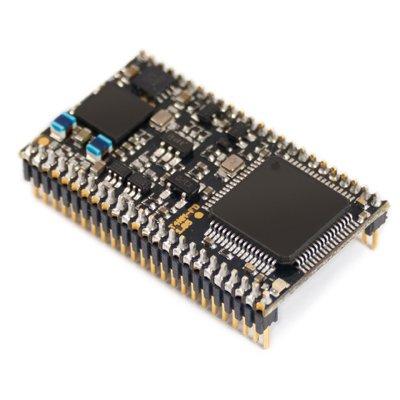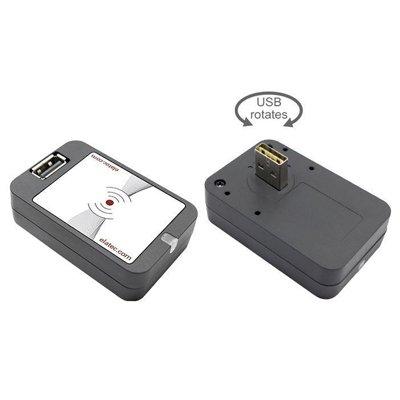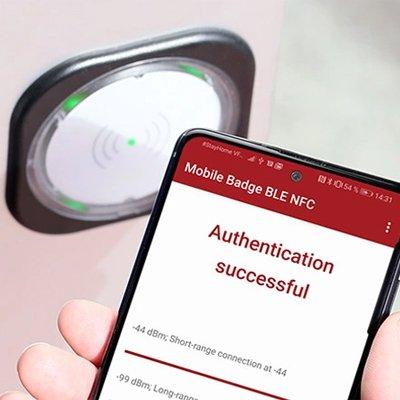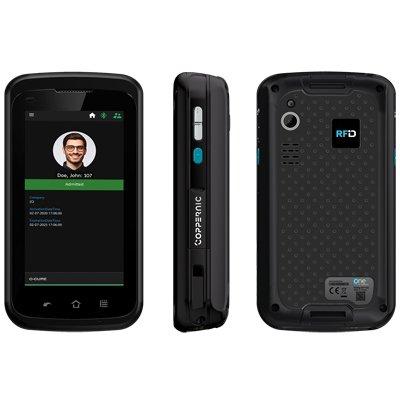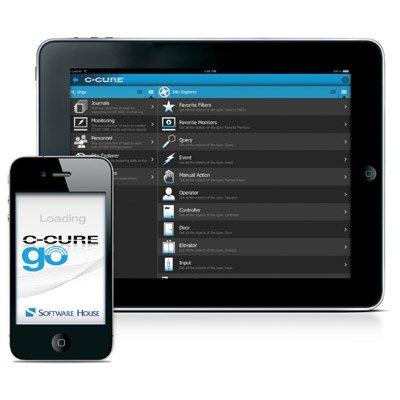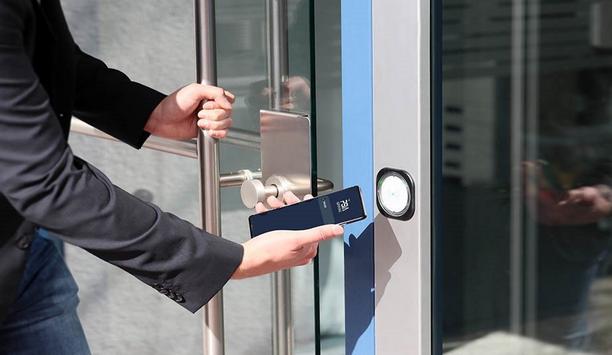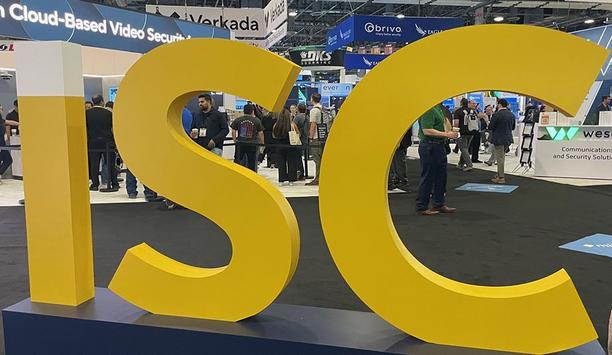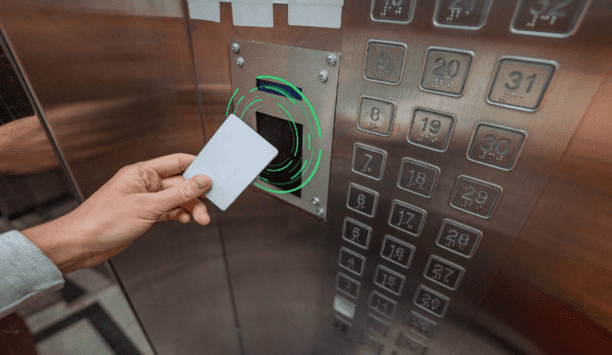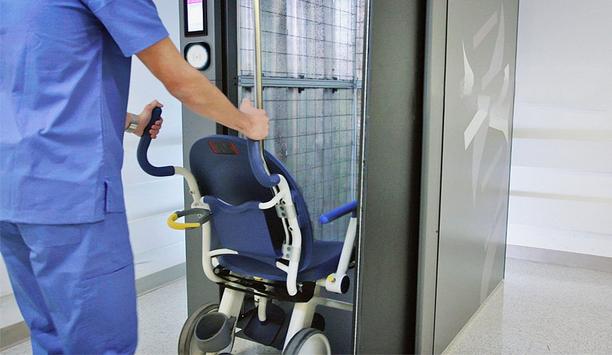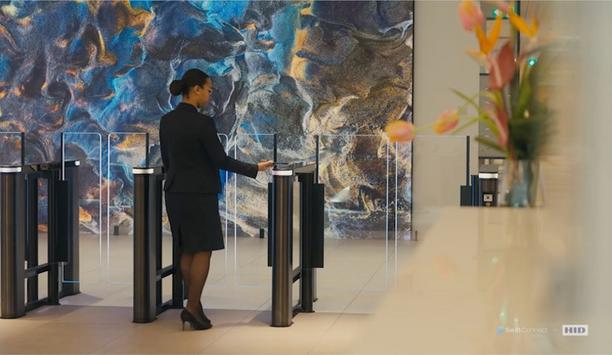Mobile access
Mobile access products


Mobile access news
Zenitel, a provider of intelligent communication solutions, announced the launch of two new door entry intercoms: the Turbine Extended Intercoms TEIV1+ and the TEIV4+. The new products display Zenitel's commitment to providing convenient and secure entry via best-in-class audio and video performance with hassle-free access control. New door entry intercoms "'Secure, Convenient Access' is the key message behind the product launch. We are excited to provide security system integrators and building owners with these new door entry intercoms,” says Peter McKeag, Product Manager for Zenitel. Peter McKeag adds, “Our goal is to help them simplify and secure their access control solutions. We also want to provide them with the freedom to select third-party accessories to meet their project's requirements.” TEIV1+, TEIV4+ The TEIV4+ is designed to provide convenient access with a card reader of the user’s choice The TEIV1+ is designed to simplify a visitor’s experience with PIN-based access control and easy-to-use scroll and direct calls. The TEIV4+ is designed to provide convenient access with a card reader of the user’s choice. With the TEIV4+ it is also possible to house access control card readers like HID & Elatec, removing the need for separate card reader mounting products. Audio and active Noise reduction features Extending on Zenitel’s world-renowned Turbine platform, both new intercoms are engineered to provide the best audio and video communication performance tailored to every environment. Zenitel’s solutions deliver the best audio technology, with Automatic Volume Control, Acoustic Echo Cancellation, and Active Noise Reduction features. HD video quality This new range further expands its feature set with a wide-angle lens and exceptional low-light performance while maintaining HD video quality. As always, Zenitel products are engineered to provide high availability, even in the most demanding environments. They are backed by Zenitel’s promise of long-lifetime components, up-to-date technologies, and long-term technical support of systems and devices.
More than one million electric vehicles are registered in the U.S.—and they all have to plug in somewhere. As EV charging stations pop up across the country, one of the chief questions will be how charging station users are identified, authenticated, and connected with membership or payment systems. Radio-frequency identification cards and tokens and smartphone authentication apps have emerged as two viable options for EV charging authentication. Which is best? It may depend on the user base they plan to serve. User authentication for EV charging Most electric vehicle owners have a spot to plug in while at home, either in their own garage or carport or in a designated charging spot in a tenant parking garage. But electric vehicles also need spots to charge while owners are out and about. The EV charging market is broadly divided into two tiers: Level 2 charging stations, which operate at 208-240 V and use AC power. These stations will add 20-25 miles of range in about an hour of charging. The U.S. Department of Transportation listed more than 22,800 public Level 2 EV charging stations across the nation as of mid-2020. They are commonly found in public parking lots and garages, hotels, grocery stores, malls, and other commercial areas. They may also be installed in private parking garages and business parking lots for use by tenants, employees or fleet drivers. Collecting membership data Direct Current Fast Chargers (DCFS) are designed to charge an EV battery to about 80% in 20-30 minutes. There are currently about 15,000 DCFC stations across the U.S., but their numbers are expected to explode as more people start taking EVs on longer road trips. They are commonly found along major interstate highways. As the market evolves, user authentication requirements for EV charging stations are likely to vary by type, location, and user base. Some commercial locations may provide Level 2 EV charging as a free amenity to shoppers, guests or employees. If there is no charge for the service, there may be no need to authenticate users at all— people can simply park and plug at any available spot. However, there may be a benefit to collecting membership data (e.g., shopper reward club). Private charging stations Public, for-profit EV charging stations, like gas stations, need a method to collect payment for their services. In some cases (especially at roadside DCFS stations), users may simply pay for the minutes used with a credit card—just like at the gas station pump. However, many EV charging station users are already accustomed to identifying themselves with an RFID membership card or a smartphone app. Charging networks like ChargePoint and Blink enable members to access any EV charging station within their networks with a card or smartphone app, which connects to their membership, account, and payment information. Private charging stations—such as those offered to tenants, employees or fleet drivers—may not require payment but need to ensure that only authorized drivers are accessing power and taking up valuable parking spots. An RFID card or smartphone app can be used to identify authorized drivers and track charging behaviors. Moving forward, many EV charging stations may find that they need a mix of options for users, including membership cards, smartphone apps, and a credit card payment option for out-of-network drivers. Choosing between RFID and smartphone apps In the long run, the answer may be ‘both.’ RFID cards are economical and easy to issue When user identification and authentication are desirable, which is the better option: RFID cards or smartphone authentication? Both have their uses in the EV charging market. In the long run, the answer may be ‘both.’ RFID cards are economical and easy to issue. And for some users bases, they may not have to issue a new card at all—they can take advantage of an RFID card they already carry. In many cases, it is possible to leverage existing employee IDs and membership cards for access to privately controlled EV charging stations. RFID membership cards may be a good bet for: Fleet drivers who already carry an RFID card for vehicle access. Employee parking lots and garages where people already use a card for entry. EV charging parking spots at gyms or other locations where users want to limit charging access to active members. EV charging stations Most consumers would prefer not to have to carry a physical membership card for every retail outlet On the other hand, public charging stations may find that consumers would prefer to use a smartphone app rather than receive another membership card to carry in a physical wallet. Many consumers prefer to carry only their phone and one or two essential cards (such as a driver’s license and a single credit or debit card). As more retailers enable consumers to pay via a digital wallet app on their smartphones, some don’t even carry a physical credit card anymore. Most consumers would prefer not to have to carry a physical membership card for every retail outlet they visit—and that includes EV charging stations. Smartphone apps for user authentication are simple to set up and highly secure. Instead of RFID, they typically use either Bluetooth® Low Energy (BLE) or Near-field Communication (NFC) protocols. Public charging stations For the user, the experience is almost identical to RFID authentication, except they wave a smartphone over the reader instead of a card. Apps have other user benefits, too. A custom app for EV charging can be configured to help users locate or reserve charging stations, check their balance and usage history, and change their payment options right on their phone. These features make smartphone authentication ideal for consumers These features make smartphone authentication ideal for consumers accessing a network of public charging stations. However, EV charging network managers should keep in mind that some users may still want a physical membership card. Smartphone-Based authentication There are still some user populations, such as older consumers and those from lower income brackets, where smartphone ownership is not ubiquitous. If users are primarily using EV charging for a fleet vehicle, they may not want to download an application for work on their personal cell phone. Other users may find smartphone apps confusing or simply prefer to have a card for other reasons. The answer for both public EV charging networks and private charging station owners is to have an RFID reader that is capable of both card-based and smartphone-based authentication. This will provide maximum flexibility as user preferences change. Finding the right RFID reader for EV charging The ELATEC TWN4 MultiTech family of readers is ideal for authentication at EV charging stations The best RFID reader for EV charging is one that is flexible enough to meet the needs of all user populations and evolve as requirements change. The ELATEC TWN4 MultiTech family of readers is ideal for authentication at EV charging stations. The readers support 60+ RFID transponder technologies along with BLE and NFC smartphone authentication. This means that one reader can support all common technologies already in use across the entire user base—both nationally and internationally. This capability becomes important for applications where users want to enable drivers to use an existing RFID card (such as their employee or fleet ID card or an access card for a tenant parking garage) for access to charging locations. It also provides more flexibility as technologies or preferences change in the future. Supporting advanced encryption TWN4 MultiTech supports advanced encryption and security configurations for highly secure transactions between the card or smartphone and the reader. This is important for EV charging applications tied to payment or employee/driver identification. ELATEC readers are mobile-ready. The ELATEC Mobile Badge BLE NFC App offers simple and effective components for building or extending a mobile application for EV charging networks. Non-managed mobile credentialing using the ELATEC app is free. TWN4 MultiTech readers also work with multiple existing third-party managed credential systems, such as KleverKey, Safetrust, and Transact. The TWN4 MultiTech is easy to customize with the powerful Software Development Kit (DevPack) and App Blaster and Director utilities. Readers can be easily configured to support custom functionality (such as LED light flashing sequences or sounds for user feedback) and integration with backend software for easier member management. The DevPack tools make the TWN4 family the most powerful, versatile, and sustainable readers on the market. Hardware communication interfaces As electric vehicles move from niche to mainstream, EV charging infrastructure will need to grow and evolve to accommodate millions more drivers—both in the consumer market and in commercial fleets. With TWN4 MultiTech, EV charging station managers will be ready. Interested in learning more about technical considerations for RFID? Download 11 Considerations for Embedded System RFID Readers for additional advice, including operating power and consumption requirements, antenna placement, hardware communication interfaces, and more.
Integrated access control and security manufacturer TDSi now announces that from 1st January 2026, it will operate under the new name: TDSi by Hirsch. The change follows the global transformation of its parent company, Vitaprotech, into the Hirsch Group, unifying its security brands worldwide under one trusted name. TDSi’s integrated access control For more than 40 years, TDSi’s integrated access control solutions have been at the heart of thousands of installations across education, healthcare, government, and commercial environments in the UK and around the world. This proven expertise remains the foundation of what we deliver. Building on that strength, our further integration with Hirsch enhances what TDSi already offers. Customers will now benefit from access to Hirsch’s portfolio of high-security Access, Perimeter and Video solutions. Together, these additions create one of the most comprehensive and cohesive security offerings in the UK market, reinforcing and extending the trusted solutions our customers rely on. The new TDSi by Hirsch brand reflects Hirsch Group’s vision of harmonising, innovating, and internationalising its security solutions, while ensuring continuity and reliability for long‑standing customers. Hirsch’s global platform Richard Huison, UK Managing Director of Hirsch Secure and TDSi, commented: “TDSi has built a strong reputation in the UK and beyond, with installations in some of the most demanding environments worldwide. Becoming TDSi by Hirsch strengthens that legacy by combining our proven access control expertise with Hirsch’s global platform." "For our customers, nothing changes in terms of service or support, it is very much business as usual. What does change is the breadth of solutions we can now offer, from perimeter to core security, giving our partners and end‑users access to a truly unified security portfolio that is scalable, interoperable, and future‑ready.” TDSi moves into next chapter TDSi joined Vitaprotech Group in 2019, followed by Hirsch in 2024. The group of security specialists will adopt the globally recognized Hirsch name on 1st January 2026, instantly conveying premium positioning, federal-grade trust, and worldwide ambition. Eric Thord remains CEO, with Steven Humphreys as Deputy CEO, driving a clear vision: global strategy, local execution, delivering innovative, interoperable security solutions precisely tailored to each market. As TDSi moves into this next chapter as TDSi by Hirsch, its commitment to its customers, partners, and the wider security community remains unchanged. All existing products, services, support channels, and points of contact will continue as normal, ensuring complete continuity throughout the transition. Customer-first approach Customers can expect to see the TDSi by Hirsch Logo begin to roll out from early next year, marking the start of a gradual evolution rather than an overnight change. With the strength of the Hirsch Group behind it, TDSi is poised to deliver even greater value while continuing to operate with the same reliability, expertise, and customer-first approach that have defined the business for over four decades.
Salto announces the launch of Salto DLok, the latest residential door smart locking solution. DLok marks a new era in Salto’s smart home innovation. This universal, motorized smart lock connects effortlessly with the Salto Homelok ecosystem to transform the residential access experience for smart homes and apartments, delivering next-level security, convenient keyless access, and automation. The DLok gives residents the power to enjoy a digital, fully automated, and universally compatible access experience in their homes. Smart locking solutions Smart locking solutions and advanced access control technologies are transforming how to protect and manage residential spaces. The DLok is engineered to meet the growing demand for connected living by offering a reliable and secure universal retrofit solution that ensures doors are always properly locked or opened without the need for physical keys, relying solely on a resident Digital Key app – a core feature of its next-generation automation capabilities. Next-level automation and seamless integration Salto’s DLok smart lock is designed for truly seamless living: Fully automated locking: Locking and unlocking now require almost no manual effort, enhancing security by guaranteeing the door is always secure. Keyless mobile access: Using the Homelok mobile app, residents can open a unit door from their phone, allowing for seamless control of home access for themselves, guests, and visitors. Salto Homelok integration: As a universal motorized smart lock, the DLok connects directly to the Salto Homelok smart living ecosystem, enabling keyless experiences and integration with the broader Salto product portfolio. Redefining mechanics, electronics, and design Additionally, DLok introduces significant engineering advancements in connectivity, reliability, and aesthetics: Universal compatibility: The DLok offers a broad range of model options and retrofit accessories designed to replace existing door hardware and fit any standard door. Universal retrofit: The DLok is compatible with virtually any door type and allows for installation or retrofit in less than 15 minutes. Crucially, the existing lock and door handle do not have to be replaced. Durable mechanics: A new, more powerful motor increases product life, certifying more than 50,000 cycles. The DLok also features a renewed metallic shaft and support parts for enhanced reliability. Precise calibration: A new magnetic calibration sensor replaces the mechanical component, improving calibration definition for more accurate and reliable lock performance and status reporting. Advanced electronics and installation: The revamped electronics are supported by Salto technology and feature a unique semi-automatic calibration option. This new system combines automatic and manual actions to significantly improve performance and the accuracy of lock status reports. Modern aesthetics: The modified flat thumbturn offers a smoother, modern look. A subtle straight mark acts as a visual reference to facilitate rotation feedback. Engineered for innovation, built for security and simplicity DLok boasts a series of significant engineering advancements geared toward enhancing longevity and reliability, all while incorporating modern aesthetics. Beyond the lock itself, Salto has also developed a new universal cylinder as well as a series of adaptor accessory options. The result is a truly universal solution; with DLok, any door in any home really can become smart in just a few simple steps. Two primary installation options Full, 15-minute installation: The DLok is a universally compatible solution, designed to make any door smart with minimal effort. The entire process – including cylinder replacement – takes less than 15 minutes. Installation is facilitated by a visual, step-by-step guide, with no drilling or additional tools required. Invisible from the outside: Minimalist, robust, and reliable design built to seamlessly blend into any door type for easy installation from inside. Keyless access for a smarter, safer home The ultimate expression of Salto’s commitment to smarter, safer, and frictionless home access, DLok caters to the needs of the modern resident, delivering both convenience and enhanced security in a single solution. Universal compatibility makes it ideal for retrofit installation – which can be completed in under five minutes. And with no need to replace the existing lock or door handle, it is cost-effective, as well. The DLok is a pivotal step in Salto’s commitment to the residential market, bringing renowned smart access expertise into the home. The innovative combination of advanced smart access technology and a sleek, universal design exemplify Salto’s ability to deliver secure, seamless, and intuitive domestic access. The DLok is poised to transform the resident experience – simplifying everyday life, enhancing peace of mind, and offering global compatibility alongside flexible installation.
Security beat
PKOC stands for Public Key Open Credential. It is a new standard that will meet a 30-year industry challenge and strip away much of the complexity and cost involved in protecting and administering credentials for access control. It could also accelerate the transition from cards to mobile access control. PKOC is a standards-based mobile credential that is essentially free, vendor-agnostic, and interoperable across multiple devices and systems. It is a highly secure access credential that can live on a mobile phone, in a plastic access card, or in any device capable of generating a public-private key pair. Access control systems PKOC is the newest standard of the Physical Security Interoperability Alliance (PSIA), a tax-exempt organization created to define, recommend, and promote standards for IP-enabled security devices and systems. PSIA introduced the Physical Logical Access Interoperability (PLAI) specification in 2013 to normalize identity data across disparate physical access control systems. The PKOC specification was introduced in 2021. We’re convinced this is the future A challenge for PSIA in promoting the PKOC mobile credential is to explain it quickly and in layman’s terms “We see the benefit of implementing the PKOC technology and doing it well,” says Sam Siegel, Senior Field Applications Engineer for ELATEC, a manufacturer of credential-agnostic readers/writers. “We wanted to get involved and join the discussion.” ELATEC has been participating in PSIA for more than a year. “This is a better way to do things,” says Siegel. “The PSIA, myself included, are convinced this is the future. The challenge is to get enough people to understand that it is a seismic shift away from what has been in place for so long.” A challenge for PSIA in promoting the PKOC mobile credential is to explain it quickly and in layman’s terms. The explanation spans the concept of public key infrastructure (PKI) and the difference between symmetrical and asymmetrical digital keys. Protecting symmetrical keys A symmetrical key system, which has been used historically in the access control market, involves the use of a single proprietary digital key to both encrypt and decrypt information. This means that digital public keys must be incorporated into each access control reader in the form of a module or a license, which the reader uses to read any compatible cards. Protecting symmetrical keys has been an expensive technology challenge the access control world The need to share these digital keys (in effect, the ability to read every compatible card) securely among access control manufacturers, integrators and end users involves extra administration and costs to ensure the security of the system. Protecting symmetrical keys has been an expensive technology challenge the access control world has borne for decades. The use of proprietary keys also promotes dependence on a single manufacturer or vendor to expand the ecosystem. The use of asymmetrical keys takes away these challenges. Advantages of using asymmetrical key pairs PKOC embraces the principle of PKI (public key infrastructure), a two-key asymmetrical system used to ensure confidentiality and encryption. In effect, there are two digital "keys," one public and one private, that are used to encrypt and decrypt information, in this case, a credential for an access control system. The secure credential standard is generated independently of a third-party credential issuer. It is generated within the device. In the access control scenario, the smartphone generates a key pair in the secure element of the phone, including a private key, which is stored on the smartphone, and a public key, which serves as the user’s ID number in the access control system. Sharing the public key is not a security risk because it is worthless without the private key that is locked away on the smartphone. PKOC-enabled smartphone The smartphone must contain the private key in order to interface with the access control system When a PKOC-enabled smartphone approaches a PKOC-enabled reader, the reader sends a one-time random number (a ‘nonce’) to the smartphone, which then encrypts it using the private key, and sends it along with the public key back to the reader. The reader uses the public key to decrypt the random number, which confirms the authorized access associated with the smartphone. The signals are sent via Bluetooth Low Energy (BLE). Importantly, the private key never leaves the smartphone and is never shared with any other elements of the access control system. Therefore, there are no administrative or technical costs associated with protecting it. The smartphone must contain the private key in order to interface with the access control system using the public key. Mobile credentialing system For ELATEC, embracing PKOC provides a new way to highlight the company’s value proposition and promote it to a new group of companies; i.e., those who adopt the PKOC approach to mobile credentialing. The ‘universal’ configuration of the ELATEC reader hardware is credential-agnostic “PKOC serves as a great way to show off our value and what we do best,” says Siegel. ELATEC provides credential readers/writers that operate in a variety of card and reader environments, incorporating an integrated BLE module to support mobile ID and authentication solutions, including PKOC. Using applicable firmware, the ‘universal’ configuration of the ELATEC reader hardware is credential-agnostic and so compatible with any RFID card or mobile credentialing system, all in a small form factor (around 1 1/2 inches square). How readers and smartphones interact The PKOC standard addresses the variables of how the reader and the smartphone share information. Currently, the PKOC standard addresses communication via BLE, but the principle is the same for systems using near-field communication (NFC), ultra-wideband (UWB), or any future protocols. PKOC also defines how device manufacturers can enable devices (readers, locks, control panels, biometric devices, etc.) to securely consume the credential for authentication and access. PKOC can be used with smart cards as well as with smartphones. In the case of a smart card, the public and private keys are contained on the smart card, which communicates via NFC with the reader. The encryption/decryption scenario is exactly the same. PKOC enables users to ‘bring your own credential’ (BYOC). Public key number ELATEC is proud to have played an instrumental role with the PSIA in the implementation of PKOC" BLE offers a broader read range than NFC; the read range can be managed using software and/or by signaling intent or two-factor authentication. Because private keys remain secure inside a smartphone, they do not have to be incorporated into a digital wallet for security purposes, although they could be incorporated for matters of convenience. To simplify administration, the public key number can be used as a badge number. If badge numbers have already been assigned, a column could be added to the database to associate badge numbers with public key numbers. “ELATEC is proud to have played an instrumental role with the PSIA in the implementation of PKOC,” said Paul Massey, CEO of ELATEC, Inc. “End-users should not be limited in their solution mix to one or two vendors due to their proprietary technology. PKOC now provides the ideal combination of security, convenience, interoperability, and cost for industry participants, by industry participants.” ‘Experience PSIA’ will promote PKOC at ISC West ISC West participants include PSIM manufacturer Advancis Software and Services The flexibility of PKOC will be on display at ISC West 2023, where ‘Experience PSIA’ will register attendees and provide them with a PKOC credential that can be used with a variety of readers throughout the show. Also showcasing the PLAI standard, PSIA’s presence at ISC West will include ELATEC along with several other vendors/manufacturers. A special PSIA event will be held from 5:30 to 7:30 p.m. on March 29 at the Venetian Ball Room B&C in Las Vegas. ISC West participants include PSIM manufacturer Advancis Software and Services, which acquired Cruatech software in 2012; and Idemia, specializing in identity-related security services including facial recognition and other biometrics. Integrated security systems Also involved are Johnson Controls (JCI), an integrated security systems provider that offers a range of security products and services; and Siemens, which offers its own range of security solutions and systems. Other participants include Last Lock, which has a unique spin on internet-enabled locks; while SAFR from Real Networks offers accurate, fast, unbiased face recognition and additional computer vision features, and Sentry Enterprises provides the SentryCard biometric platform for a privacy-centric, proof-of-identity solution. Finally, rfIDEAS manufactures credential readers.
Multiple technology trends are transforming the physical access control market. There is a fundamental shift away from physical cards and keys toward digital identities — mobile credentials, digital wallets, biometrics, and cloud-native access platforms. These next generation access solutions are radically reshaping how buildings operate, protect staff, and perform functionally. At the same time, AI and analytics solutions are being layered onto these physical access control systems to support predictive threat detection and behavioral insights. Access data itself is becoming an asset for sustainability, space optimization, and smart building initiatives. Risk, impact operations and experience The annual HID Global Security and Identity Trends Report highlights these and other issues The annual HID Global Security and Identity Trends Report highlights these and other issues. The survey cites improving user convenience as a priority for nearly half of organizations, while 41% are focused on simplifying administration, and 28% struggle with system integration. These are not theoretical challenges, they are day‑to‑day friction points that add cost, increase risk, impact operations and experience, and, of course, must be addressed. HID Global’s commercial focus HID Global’s commercial focus is to help organizations digitize their access control — with mobile identities, biometrics, and cloud platforms — and then to use the data to deliver more value. “We are turning access control from an operational cost into a software-driven asset that improves efficiency, supports Environmental, Social, and Governance (ESG) goals and even creates new revenue opportunities,” says Steven Commander, HID Global’s Head of Consultant Relations. The impact of digital transformation Digital transformation is the method of moving access control from hardware and physical credentials Digital transformation is in the process of moving access control from hardware and physical credentials to a software-driven, integrated experience. The transformation strengthens security while also improving user convenience — transforming the “pavement to the desk” journey. HID enables this shift through mobile credentials, biometrics, cloud-native platforms, and solutions that allow third-party applications to run on door hardware. “This helps customers turn access data into operational and commercial outcomes, while also improving the overall user experience,” says Commander. Digital transformation in access control is not focused on chasing the latest trends. Rather, transformation is about turning software, data and integration into outcomes that matter to customers, says HID. “Security becomes stronger and more adaptive,” says Commander. “Operations become simpler and more cost‑effective. Experiences become seamless and consistent. Sustainability moves from ambition to action. And the financial case becomes clearer as efficiencies are banked and new value streams emerge.” The challenge of futureproofing with long lifecycles Given that physical security technologies will be in place for 15 to 20 years, it is important to plan for how systems can evolve over time. Considering how rapidly security threats, compliance standards, and user expectations change, 15 to 20 years is a long time. The decisions made at the beginning of a system’s lifecycle can either limit flexibility later (which will be costly) or enable long-term adaptability. Support for open standards such as Open Supervised Device Protocol (OSDP) is therefore important Choosing products and platforms that are open, interoperable, and designed for updates can enable future-proof projects. Support for open standards such as Open Supervised Device Protocol (OSDP) is therefore important. In addition, systems built on open controller platforms — such as Mercury — enable organizations to switch software providers or expand functionality without replacing core door hardware. Architectural openness is key to system lifecycles and maximizing the return on investment (ROI) from a chosen solution. Digital credentials and mobile access Flexibility and upgradeability should also be top of mind when it comes to endpoints like access control readers. While RFID cards are still commonplace, there is a clear trend toward digital credentials and mobile access. Readers that support both allow organizations to transition at their own pace, without committing to a full system overhaul. A long system lifecycle does not mean technology should remain static. Security, particularly cybersecurity, demands more frequent updates. Technologies that support firmware upgrades in the field extend the value of a deployment while helping organizations keep pace with emerging threats. In that sense, lifecycle thinking is not just about longevity — it’s about maintaining resilience and readiness over time. Applying biometrics and mobile identities Biometrics is becoming mainstream as a credential alternative, strengthening security without adding friction Biometrics is becoming mainstream as a credential alternative, strengthening security without adding friction. Many organizations are now deploying biometrics to support fast, seamless access journeys, with adoption already around 39% in access control according to HID’s recent research. In addition, 80% of organizations surveyed expect to deploy mobile identities within the next five years. Full technology integration enables tap‑to‑access without opening an app; the user journey becomes faster, safer, and more convenient. “It is where the industry is headed and we are at the vanguard of this,” says Commander. Ongoing challenge of cybersecurity At HID Global, cybersecurity is embedded into everything, from corporate processes and development practices to the solutions they bring to market. “Our approach ensures that customers can strengthen their overall security posture, not only by deploying secure products but by benefitting from HID’s commitment to the highest industry standards,” says Commander. HID holds multiple globally recognized certifications, including ISO 27001, ISO 14298, SOC Type 2, and CSA STAR, which demonstrate their robust information security and cloud security practices. In addition, HID’s SEOS® secure chipset is independently SEAL-certified, providing one of the most advanced levels of protection available on the market today. “Ultimately, this means organizations are not just purchasing isolated secure products; they are implementing solutions developed and delivered within a comprehensive, cybersecure framework,” says Commander. “When deployed according to best practices, HID solutions enable customers to achieve the highest levels of resilience against evolving physical and cyber threats.” Developing green and sustainable solutions A huge amount of waste is generated from the manufacture of plastic RFID access cards Digital credentials align with the sustainable solutions that everyone wants. A huge amount of waste is generated from the manufacture of plastic RFID access cards. Over 550 million access cards are sold annually. This creates 2,700 tons of plastic waste and 11,400 tons of carbon, based on a PVC card weighing 5 grams. Therefore, digital credentials self-evidently reduce the reliance on plastic cards (helping reduce carbon emissions by up to 75% according to HID’s research), while leveraging access control system data supports energy optimization by shutting down or reducing systems in unused spaces. Energy use and CO₂ emissions can be cut dramatically, showing how access systems can contribute to sustainability goals and green building certification. What is the latest in smart buildings? Smart buildings increasingly rely on mobile access control as the backbone for digital services. Real-time access data enables new services such as automated room bookings, HVAC control, lift/elevator calling, e-bike hiring, and so on. Smart buildings increasingly rely on mobile access control as the backbone for digital services The financial upside is clear; smart, digitally transformed buildings can deliver around 8% higher yields per square foot versus traditional office space. Operational savings accrue from reduced administration, the removal of card production and shipping, and lighter IT support. This creates a value cycle — better experiences drive adoption, adoption fuels monetization, and monetization funds further improvements. Achieving technology impact in the real world One standout project is One Bangkok – a $3.9 billion mixed-use development in Thailand – which demonstrates the scale of what can be achieved when access control data is used for optimization, particularly when it comes to monitoring facilities usage and occupier behaviors. By switching lights off or lowering the temperature in unused rooms, for example, the One Bangkok building demonstrates this potential with a 22% reduction in energy consumption, saving 17,000 MWh and 9,000 tons of CO₂ annually. Sustainability is a key factor in contributing to how properties are valued. And sustainability extends far beyond digital credentials having a lower environmental impact than plastic cards. Buildings with recognized sustainability certifications often command rental premiums of around 6%, and three‑quarters of security decision‑makers now consider environmental impact in their procurement assessments.
ISC West 2025 in Las Vegas showcased the latest advancements in security technology, offering security professionals a glimpse into the future of the industry. This year's expo highlighted the growing influence of artificial intelligence (AI), cloud computing, and enhanced integration. The pioneering comprehensive and converged security event attracted nearly 29,000 industry professionals to the Venetian Convention Center. Integration into unified platforms Several companies emphasized the importance of cloud-based solutions and the integration of diverse security components into unified platforms. For example, Brivo's Security Suite provides “everything in one platform” – not just access control. Customers only pay for what they use because the system is flexible and scalable from a single door to enterprise level applications. Brivo’s suite includes video, but the system can also tie in with third-party “partners.” Genetec's Security Center allows for more frequent updates through the cloud. Milestone is undergoing a two-year transition to bring its Xprotect system into the future by incorporating Arcules and Briefcam into a video-as-a service product. Suprema introduced BioStar X, which integrates access control and video analytics into a single platform. AI and mobile credentials Axis Communications’ Cloud Connect product announced three new partnerships at ISC West 2025 Axis Communications’ Cloud Connect product announced three new partnerships at ISC West – Eagle Eye Networks, SecuriThings, and Wesco. They join the three partners announced during the first year of Axis Cloud Connect – Genetec, Kone (elevators) and Milestone. AI and mobile credentials were still hot topics at ISC West 2025, but the conversation has evolved beyond amazement at the technologies’ capabilities and now centers on more practical aspects. From the theoretical to the practical “AI and mobility are still the ‘flavors de jour,’ but messages are evolving to manifest AI for better outcomes,” says Heather Torrey, General Manager, Commercial Security, Americas, for Honeywell Building Automation. The company has reframed its security portfolio to be very building- and business-focused, continuing to grow and evolve after the recent acquisition of LenelS2. “From the theoretical to the practical, we want customers to be part of the conversation so we can deliver AI that is meaningful to them, focusing on what’s most important,” says Torrey. Under Honeywell’s new ownership structure, “each part of the business can be more focused on customers’ needs,” she says. Honeywell continues its journey around mobile access and credentialing and migrating to cloud solutions. Innovations in Access Control Gallagher’s new Quickswitch access control board simplifies the migration from legacy systems Access control remains a critical component of security systems, and ISC West 2025 showcased several innovations in this area. Acre is releasing “Gallery,” its version of the App Store for access control. DormaKaba is launching the Keyscan KC Series door controller with TCP/IP connectivity and enhanced features. Gallagher’s new Quickswitch access control board simplifies the migration from legacy systems. Johnson Controls highlighted its C-Cure command center and C-Cure IQ web client, offering a unified approach to access control and video. Hardware integrations for security panels For service provider Alarm.com, hardware products prepare a path to greater customer experiences, says Abe Kinney, Alarm.com’s Director, Product Management, who oversees hardware integrations for security panels, sensors, video, etc., and drives new product development. “We are looking to bridge the physical world to digital world,” he says. “We want to bring an advantage to our dealers that they can bring to customers.” Because Alarm.com’s customers pay a monthly fee, the products must be durable and economical, says Kinney. “It should work with no need for truck rolls.” The importance of longevity and flexibility Products are evaluated based on features, price, and ease of installation Products are evaluated based on features, price, and ease of installation. In particular, longevity is important for the Alarm.com’s pro channel. There is also a growing emphasis on deterrence industrywide. Says Kinney: “We recognize that detection is part of it, but we need to prevent problems from happening in the first place. And the industry is re-evaluating.” When it comes to cloud intelligence, Eagle Eye Networks puts the emphasis on flexibility. They offer AI that can perform anywhere on the system infrastructure, on the camera, on their on-site bridge device, or in the cloud. They support their own AI and also any AI product from a third party. “We focus on what customers want from the data AI detects,” says Hans Kahler, Eagle Eye Networks’ Chief Operating Officer. Integration with other systems A timely alert from gun detection could save a life, but AI can also generate information that might be used and analyzed later, such as point-of-sale information, dwell time, foot traffic, etc. “What people want is the ability to work with the data for business intelligence,” says Kahler. Integration with other systems provides new opportunities for customers: For example, a license plate reader at a restaurant drive-thru could trigger customization of the menu board digital signage based on the customer’s previous buying pattern. Relentless Innovation Assa Abloy handles more than 40 million SKUs for all its various brands, faked in 28 factories in the US Assa Abloy handles more than 40 million stock keeping units (SKUs) for all its various brands manufactured in 28 factories in the United States. Merely complying with regulations such as the “Buy American Act” is a monumental effort considering the massive product line, attendees heard at Assa Abloy’s Annual ISC West Breakfast focusing on compliance challenges in the security market. Meanwhile, back at the trade show booth, Assa Abloy focused on “relentless innovation” in every corner of its product line. Assa Abloy’s message: Innovation in security does not have to be about AI or automation. In fact, inventive approaches to products come in all shapes and sizes and at every level of the product portfolio, and innovation is happening faster than ever. For example, the Safebolt product from Securitech, a brand recently acquired by Assa Abloy, can quickly lock down existing doors with the press of a red button on a cylindrical or mortise lock. Temporary Systems to Secure Events Securing events is the focus of Allied Universal's Unified Command Solutions, which specializes in setting up temporary security systems for conventions, trade shows, festivals, construction sites, parades, and other events. They can add technology to situations where previously mostly security officers were used, providing safety/security and enabling more efficient event operation. “We can put cameras anywhere, whether they need power or not, use cell service or WiFi, a localized network or the internet, or whatever,” says Andrew LaMadrid, VP, Sales for Allied Universal's Unified Command Solutions. Event operation and management IDIS came to ISC West looking to leverage new products that they did not promote in the past The focus is on easy implementation, flexibility, and fast setup and removal. “We look for a solution to solve each customer’s pain points,” says LaMadrid. They specialize in setting up and deploying surveillance cameras for safety/security and for event operation and management. Mobile surveillance is a relatively new “piece of our puzzle” when it comes to protecting high-profile events. “People are excited about what we can offer that’s new,” says LaMadrid. Unified Command Solutions has been around for about 12 years and was acquired by Allied Universal last summer. IDIS came to ISC West looking to leverage new products that they did not promote in the past, and visitors were very interested in those solutions, says Scott Switzer, IDIS CEO. “The progression of our product line has been tremendous,” he says. Last year, the IDIS booth offered only basic analytics, but this year they had 30 different advanced analytics including gun and aggression detection using the advanced solution “IDIS Vaidio AI.” What Makes You Different? The most common question IDIS hears at their trade show booth is: “What makes you different?” The answer: They offer an end-to-end solution, including cameras; they manage, control, design from end-to-end; and there is no need for multiple integrations. The time needed to install an IDIS system is significantly less because of the simplicity. “We have customers we have supported and grown together for over 20 years,” says Switzer. The company previously deployed IDIS cameras under the Costar brand before the Korean IDIS brand was introduced into the U.S. (IDIS purchased Costar and changed the name to IDIS America.) “This has been a tremendous show for us; we are looking to build our momentum and let more people know about IDIS,” says Switzer. Managing real AI at the edge The depth of their metadata enables new applications, whether for security or business operations Based in Prague, Czech Republic, and with U.S. offices in Pennsylvania, FF Group provides license plate recognition for harsh environments. Using Axis cameras, they offer “managed real AI at the edge,” selling through a nationwide distributed network, says Alex Osypov, CEO and Founder of FF Group. Markets include parking lots, cities/municipalities, police, government, water systems, etc. The depth of their metadata enables new applications, whether for security or business operations. They are looking to combine and correlate data including LIDAR, RADAR, etc. to exploit the advantages of “data fusion.” Osypov says: “The market is growing because we are involving other adjacent markets.” Unified platforms and advanced tools Several companies are focusing on enhancing security operations centers (SOCs) by providing unified platforms and advanced tools. Axon’s Fusus system “layers” onto existing infrastructure, tying together various sensors into a single interface for real-time monitoring and information sharing. Increasingly, enterprises have invested in a lot of technologies – ac, video, asset trackers – but none of it talks together. Fusus ties all the systems together so that operators no longer have to look at 10 different screens. Rather, there is a “single pane of glass” that shows everything and facilitates sharing of information with law enforcement. Motorola also showcased its Security Operations Center, which integrates hardware, software, smart sensors, communication radios, and broadband devices to streamline incident management.
Mobile access articles
RFID and emerging mobile access technologies are easy to implement and allow elevator access to be integrated with other access control solutions throughout the building, from building entry to printer access. The right RFID reader can help reduce complexity by migrating diverse older technologies into a single convenient solution. Ways RFID Works Radio-frequency identification (RFID) and smartphone-based credentialling systems using Bluetooth® Low Energy (BLE) or Near-Field Communication (NFC) improve building security by limiting floor or elevator bank access to authorized persons. An RFID reader is integrated with elevator control panel. Employees or tenants use an RFID card (typically the same ID card they use for facility access) or smartphone to authenticate themselves when they step into the elevator. The RFID reader sends information to a software system that unlocks the floors that the person is authorized to access. Buttons for floors the user is not authorized to access remain non-operational. Benefits of RFID RFID provides a number of benefits for end users, building managers, and solution providers. RFID builds on existing building security infrastructure, such as an employee ID or tenant access card, or a smartphone. RFID provides simple, fast, and convenient access to building floors for authorized employees or tenants—all they have to do is wave their ID card or smartphone in front of the elevator access panel. Access can be managed through a centralized system, so elevator users can only access floors they are authorized to visit. Access can be managed by elevator bank or floor to restrict access to secure or members-only spaces or support the security needs of tenants in multi-tenant buildings. Choosing RFID Reader RFID readers/writers come with a broad range of capabilities and configurations RFID readers/writers come with a broad range of capabilities and configurations. One should make sure to invest in an option that provides the flexibility and security required to meet customers’ requirements for flexibility, convenience, and security. If one has multiple older technologies in place, one should look for a universal solution that will allow easy migration of all systems into a single solution that works with any transponder technology, anywhere in the world. It must provide flexibility so it will continue to meet needs for years to come as device specifications and end-user requirements change. The key to a successful implementation depends on hardware, software, and service—and how they all work together. When choosing an RFID reader, one should take all of these factors into consideration.
Access control solutions will continue their evolution in 2025 as organizations assess and adapt to dynamic and increasingly dangerous threats. Trends to watch include the growing adoption of mobile access credentials and digital IDs, and the integration of digital and physical security and other technologies. Other ongoing trends include the integration of AI into access control solutions and the increasing adoption of contactless biometrics for enhanced convenience. New access control innovations As these trends gather momentum, they highlight the pivotal role access control systems play in combining security and convenience, every hour of every day. Organizations must strike the ideal balance between a secure environment and satisfying user experience if they are to meet increasingly vocal demands for both. Achieving this balance not only delivers the expected user experience but also delivers multi-layered threat protection while introducing exciting new access control innovations. Digital technologies and open standards Modern access control solutions deliver a faster pace of innovation and dramatically improved capabilities Modern access control solutions deliver a faster pace of innovation and dramatically improved capabilities as compared to what was possible in the past. The primary objective is no longer simply to secure places and assets so they are beyond the reach of the wrong people. Now it also must be as easy as possible for authorized individuals to enter a building or access digital assets. Mobile access credentials and digital IDs are increasingly a preferred solution for achieving this seamless and convenient access experience. Technology convergence is happening at a rapid pace and this convergence makes it possible to integrate digital and physical security with real-time location systems and other technologies. Together, these converged technologies provide multi-layered protection against both cyber and physical threats while also enabling valuable new capabilities. 2024 State of Physical Access Control Report As AI is increasingly incorporated into access-control solutions, we will see even more powerful ways to leverage access control data for analytics use cases. Almost 40% of respondents to our 2024 State of Physical Access Control Report said they were looking to do this. Equally consequential is the rise of fast, frictionless and easy contactless biometrics solutions in a wide range of applications including healthcare, where 32% of respondents to our recent 2024 State of Healthcare Security Report said their facilities have already implemented this technology for authentication. Looking at the broader marketplace, nearly one in four (23%) respondents to our 2024 State of Physical Access Control Report cited biometrics when asked to “name the top three trends shaping the wider access control industry in the near future.” Evolution of access control solutions As access control solutions become increasingly central to secure and convenient daily life, these and other trends will have an ongoing impact on all market sectors from healthcare and banking to the corporate real estate enterprise and business and college campuses. At the same time, those responsible for a facility’s digital and physical assets know that these trends – and security in general – will never be a static proposition. The only constant is change. Threats will never stop evolving, and those tasked with protecting organizations against these threats must never stand still. The evolution of access control solutions that we saw during 2024 will continue through 2025 and beyond, and organizations will need to remain thorough and vigilant as they address today’s ever-expanding attack surfaces and ever-evolving attack schemes.
When a bomb detonated in the Port of Beirut, I had hundreds of employees under my care inside the blast zone. Within just two hours, I was able to determine who was impacted, understand their safety conditions, and share resources for on-the-ground support—all thanks to mobile technology. For Chief Security Officers, receiving calls like these launches a variety of protocols and necessary decision-making with the safety and security of people and assets as a top priority. And these calls are only becoming more common. Dependence on threat intelligence Mobile phones have dominated the post-COVID environment where people work from anywhere Threats ranging from natural disasters to geopolitical conflicts are becoming more frequent and complicate the responsibility organizations have in keeping their people safe. To meet these needs CSO’s are staying ahead of negative outcomes through creating a greater dependence on threat intelligence. In these times, effective, real-time risk management depends on hyper-local data from technology that is accessible, portable, and dynamic – such as cell phones. Mobile phones have revolutionized the way people live and work. They allow us all to walk around with a computer in our pocket, bringing the world to our fingertips and eliminating digital borders for over 90% of the world's population. Mobile phones have dominated the post-COVID environment where people work from anywhere and have geographically distributed teams but are also more vulnerable to threatening events. Mobile-friendly risk management platforms Mobile technology assigns workers with easy entry to data that can help keep them and their teams safe As we approach 2024, many organizations are adopting comprehensive risk management tools that empower personnel across the organization with the intelligence and knowledge they need to stay safe wherever they are. Mobile-friendly risk management platforms, such as Crisis24 Horizon, provide always-on awareness, on-hand threat intelligence, and immediate communications and distress signaling through location monitoring. Users receive location risk assessments and push notifications directly to their devices about nearby issues and threats no matter if they are on or off the job. While only select risk managers have complete control of the platform and all sensitive employee data is protected through encryption, the app distributes critical intel to foster a culture of shared awareness and responsibility. Thus, mobile technology empowers employees with easy access to information that can help keep them and their teams safe. Creating a culture of mobile technology adoption In the last few years, the world has proven the importance of being well-informed of risks and mitigation plans to minimize harm. However, psychological barriers tend to trump physical barriers when it comes to accessing the vast array of tools our mobile devices offer. World has proven the matter of being well-informed of risks and relief plans to minimize harm Adopting this technology and establishing a culture that enforces risk management across an organization is a daunting challenge that demands substantial commitment from leadership to be successful. Some companies have tackled this challenge by positioning security technology as part of the organization’s employee benefits package, such as commuter benefits and health insurance, to encourage people to take advantage of these resources and learn how to use them. Cohesive risk management culture Technology is only as effective as the people whose actions it informs, which is why adoption and integration are so important. When a cohesive risk management culture meets a powerful technology platform, individuals are enabled to receive threat alerts and counter their impacts, letting others know when and how to take the necessary precautions to protect themselves and their team. For more information on mobile technology and other security trends, check out the Global Risk Forecast, an annual report by Crisis24 that provides a comprehensive analysis of key events around the world most likely to affect operations in the coming year.
Mobile access case studies
Caron Engineering needed a smart, secure RFID reader that would allow them to add operator authentication and log-in to their solutions for US and international CNC machining market customers and to enable those customers to use their current employee badge system. The reader needed to: Provide secure and accurate user identification, authorization, and access control. Read all of the RFID card technologies their clients might be using. Be easy to reconfigure for new technologies of functionality. Mount cleanly and securely to the exterior controls area of their machines. Be able to withstand industrial environments. Situation Established in 1986, Caron Engineering Inc develops advanced sensor and monitoring technology to optimize performance, productivity, and profitability for the machine tool industry. Their largest customers are in the aerospace, medical equipment, and defense industries. Demands These products utilize high-precision sensors and high-speed data processing units to make real-time adjustments Caron Engineering’s smart manufacturing products are sold worldwide and interface with virtually all CNC machine tools on the market. These products utilize high-precision sensors and high-speed data processing units to make real-time automated adjustments, optimize machining, and provide valuable information about the cutting process and the machine’s health. Finding and retaining skilled operators is increasingly tricky for Caron Engineering's customers. As a result, operator training demands are high, and so there is a need for workforce tracking and continuous process optimization. Challenge Caron Engineering realized that the "who" is typically the missing link in manufacturing data. Understanding operator identity is the key to enabling data-driven decisions in the modern factory. Machine authentication allows plants to incorporate worker activity at a granular level within the production environment and ensures that only trained, authorized operators can access machine controls. Lack of traceability with physical keys Access control is enabled using passwords and PINs, often forgotten or likewise shared among staff When there is access control, current machine access control is typically done with physical keys, keys often left in the machine, lost, or shared among the workforce. Or access control is enabled using passwords and PINs, often forgotten or likewise shared among staff including staff who shouldn’t be touching the equipment or performing a specific function. Generally, there is no traceability; when something goes wrong, the responsible party is unknown. Need for RFID solution Caron Engineering and its customers required an RFID reader solution to integrate with their MiConnect CNC control interface software to ensure only authorized operators could access equipment and specific software. They also needed authentication to ensure operators were adequately trained and traceability for reporting and improvement purposes. With the shortage of skilled operators, such training is essential for process optimization. Solution The ELATEC TWN4 Slim reader met The Slim is configurable for all the major RFID card transponder technologies used worldwide Caron Engineering’s requirements and more. The Slim is configurable for all the major RFID card transponder technologies used worldwide, more than 60, maximizing their market opportunities and helping them better serve customers using multiple technologies. Their customers use the same corporate ID cards used for building entry to grant authorized employees access to their manufacturing software and equipment. Remote configuration With its flexible architecture and open API, the Slim reader can be remotely re-configured to activate new card technologies or upgrade firmware to meet emerging security and functionality requirements. Or a contactless card may be presented to the reader, no touch labor required. The Slim is integrated with the Caron Engineering middle- and backend software, so every time an operator or maintenance worker runs the equipment, it is logged along with who did it when they did it, and what actions they performed. Machine operator authentication and access control Caron Engineering has hundreds of its MiConnect software applications installed in locations around the world. And where it has been implemented with the TWN4 Slim reader, it provides secure, reliable machine operator authentication and access control to help their customers ensure workforce training authorization and safety to optimize their manufacturing processes. Optimized turnkey solutions It helps eliminate errors by knowing exactly which operator is doing what and allows reporting back" “RFID-enabled machine operator authentication provides a check and balance. It helps eliminate errors by knowing exactly which operator is doing what and allows reporting back to the operator for improvement and where training is needed. They have accountability through the badge reader system." "Our goal is to provide turnkey solutions for our customers to optimize and control their production processes. Machine operator authentication and tracking with ELATEC RFID badge readers helps us do just that,” Rob Caron, CEO, of Caron Engineering, Inc. Benefits Integrating the ELATEC TWN4 Slim reader has significantly benefited Caron Engineering's machining customers. Firstly, the seamless integration of the Slim reader with existing corporate ID cards has streamlined access control processes. authorized employees conveniently use their familiar ID cards, eliminating the need for additional access credentials and reducing administrative burden. Secondly, the comprehensive traceability of the Slim reader with MiConnect software enables effective monitoring of operator activities. Detailed information, including the operator, timestamp, and equipment used, is tracked, fostering accountability and facilitating targeted analysis for troubleshooting and process improvement. Lastly, the Slim reader's flexible architecture and open API ensure future-proof functionality. Remote reconfiguration capabilities allow easy adaptation to new card technologies or firmware upgrades, ensuring compatibility with evolving security standards and industry requirements. Implementing the ELATEC TWN4 Slim reader empowers Caron Engineering's customers with enhanced workforce management, improved security, and optimized manufacturing processes.
UV-Concepts develops and manufactures innovative no-touch disinfection solutions using the ultraviolet UV-C germicidal wavelength of 254nm. Their flagship product is the UVE™ UV-C Enclosure, a purpose-built platform for the disinfection of primarily portable medical equipment in hospitals and other healthcare environments. Safety with RFID reader Healthcare-associated infections (HAIs) have been in the spotlight for decades, but with the COVID-19 global pandemic, infection control and prevention have become urgent priorities. The RFID reader provides a critical safety layer because of the risks of exposure to UV light. Staff is trained in the proper use of the device and only then are they authorized via their RFID badge to operate the equipment. Proper operation is tracked and flagged where additional training may be necessary. Badge reading Badge reading allows administrators to have complete oversight of the personnel using the product" “Badge reading is an essential component of our protocol management platform,” says Jeremy Starkweather, CEO, UV-Concepts. "This allows administrators to have oversight of the process, and also allows them to have complete oversight of the personnel using the product. It also helps us understand if somebody is using the product appropriately.” Challenge UV-Concepts realized the limitations of the previous readers they were using. First, as the readers were not multi-technology, they could not accommodate customers that used a mix of RFID card technologies at different locations or who changed technologies after implementation, except by issuing additional RFID. Second, their readers were single, a low frequency which limited the degree to which they could secure confidential information such as employee names and badges. Third, the readers could not be customized to provide the audible and visual feedback UV-Concepts desired for the user, And finally, the previous readers were not aesthetically consistent with the high-tech design of the UVE™. UV-Concepts wanted a single reader that would work with all of the technologies used by their customers. The reader needed to be secure and encryption-capable, easy to reconfigure after installation to meet the needs of customers who changed card technologies, and look like a high-tech medical equipment component should. Requirements: smart, secure RFID reader solution UV-Concepts wanted a smart, secure RFID reader solution that would meet the needs of its burgeoning global healthcare and commercial market customers. The reader needed to be able to: Provide secure and accurate user identification, authorization, and access control. Read all of the card technologies their clients might be using. Be easy to reconfigure for new technologies or functionality. Have a high-aesthetic quality consistent with their product design. Solution: ELATEC TWN4 Palon Compact Panel Reader The Palon is configurable for 60+ RFID card transponder technologies, maximizing market opportunities The ELATEC TWN4 Palon Compact Panel Reader met all of UV-Concept's requirements and more. The Palon is configurable for 60+ RFID card transponder technologies, maximizing their market opportunities and helping them better serve customers using multiple technologies. Their customers can use the same corporate ID cards that employees use for front door access to enable access to the UVE™ for authorized employees. Contactless solution with UVE™ digital tagging With its flexible architecture and open API, the Palon can be remotely reconfigured to activate new card technologies or upgrade firmware to meet emerging security and functionality requirements. Or, a contactless card may be presented to the reader, no-touch labor required. The Palon is integrated with the UVE™ digital tagging system and backend software so every time a disinfection cycle runs it is tracked along with who did it, when they did it, and what they did it on. Secure, reliable user identification and access control The reader helps its customers ensure staff authorization and safety in the disinfecting of medical equipment UV-Concepts has dozens of the UVE™ installed in locations around the world. And its TWN4 Palon Compact Panel Reader provides secure, reliable user identification and access control to help its customers ensure staff authorization and safety in the disinfecting of medical equipment, and most importantly, the protection of the vulnerable patients served. “Even though it's a component, the ELATEC reader is essential to the UVE™ process and safety. I believe UV-Concepts are making an impact on this planet with our technology. What you guys are doing is making an impact too, so thank you for that,” said Jeremy. Product: TWN4 PALON compact panel reader Compact and adaptable Reads 60+ transponder technologies Certified for use in numerous countries Easy to reconfigure Robust polycarbonate housing ELATEC recommended the TWN4 Palon Compact Panel Reader, a compact and powerful RFID reader/writer with flexible architecture and open API that can accommodate 60+ card technologies. Benefits Compatible with numerous RFID badge technologies. Compact to fit the form-factor of customer hardware. Supports rapid contactless configuration and updates. Easy and secure installation and integration.
How do you rethink and transform building access for a 241-year-old company? BNY started by asking employees. The response was encouraging. The BNY team found that employees embraced the concept of mobile access solutions. The thought of implementing access solutions was already being considered by the company and the team was excited about the idea of providing a modern experience that allows employees worldwide to conveniently access their building spaces with a simple iPhone or Apple Watch. How powerful of a concept “The whole idea of people navigating around our facilities globally — it just brings a smile to your face,” said Ken Damstrom, Global Head of Corporate Security at BNY. “But it really brings a smile to their face because when they come to work they come with their iPhone they don’t necessarily need to come with their (physical) ID badge and how powerful of a concept is that?” Getting started with the right team To put everything in motion, BNY engaged connected access network provider SwiftConnect and mobile access provider, HID. Selecting experienced and reputable partners was important for BNY, along with the technologies that they brought to the table. For this project, those technologies included employee badge in Apple Wallet alongside HID’s mobile-enabled Signo readers and the reliability of the SwiftConnect connected access network. How does the technology work? Two key components of BNY’s initiative were essential to its success. Employee badge in Apple Wallet, paired with HID’s mobile-enabled Signo readers gives employees and their guests easy and secure access to corporate spaces using only their iPhone or Apple Watch. Users can simply hold their device near a reader to access doors, turnstiles, elevators, spaces and more. SwiftConnect unifies identity and physical access into one effortless experience, connecting systems and spaces into a unified network. It supports on-demand access via mobile credentials and optimizes existing methods like fobs and cards for secure, consistent access — replacing friction with fluidity at every interaction. “What we learned by partnering with SwiftConnect and HID was employee badge in Apple Wallet was absolutely ready for prime time,” said Ken Damstrom. “We’ve had nothing but confidence in rolling it out in our organization.” Making mobile access technology a reality With full support from their partners, BNY launched their new mobile access solution at their headquarters in New York City, then expanded to other offices in Boston, London and India, as well as others. They’ll continue until every BNY office worldwide is using the technology — at 110 locations in 35 countries. Regardless of which country the technology is implemented, employee badge in Apple Wallet will work the same across BNY’s facilities. That’s important because their employees can seamlessly and securely enter and move around multiple locations. Also, with Express Mode, employees do not need to unlock their device to use their employee badge in Apple Wallet. Even if the phone needs to be charged, the device can still be used to access spaces with Power Reserve mode. Advantage of privacy and security When an employee has an employee badge in Apple Wallet, their data is never shared with Apple or stored on Apple servers. If their iPhone or Apple Watch is misplaced, the owner of the device can promptly use the Find My app to lock the device and help locate it. Employee badges in Apple Wallet are stored on personal devices and take full advantage of the privacy and security built into iPhone and Apple Watch. “We wanted consistency across our real estate portfolio, so whether you’re in New York, Lake Mary or London, you know how to access the site because you know how to use employee badge in Apple Wallet,” said Dafna Alsheh, Global Head of Workplace Experience & Design, BNY. Combination of technologies The combination of these technologies is now helping BNY create that convenient, quick access experience for employees — while ensuring a secure workplace. “One of the things that makes employee badge in Apple Wallet really impactful is that it works the same at work as it does when they’re at the store or on the subway because you don’t have to teach people how to use it,” said Dafna Alsheh. “We’ve had people who are like, ‘wow this just works.’ But when they realize they can use their Apple Watch, then they’re like, ‘this is magic.’”
SwiftConnect is excited to expand into the higher education market through its landmark deployment of NFC-enabled digital student ID cards for the University of Arizona. Earlier this month, the university announced that its 53,000 students and 16,000 faculty and staff can now add their CatCard to Apple Wallet or Google Wallet and use their iPhone, Apple Watch, or Android Phone to access campus buildings, purchase meals, and experience many other campus moments with a single tap of their mobile device. Connected access platform The agnostic platform also operates independently of proprietary hardware or software Through its connected access platform powering the new mobile CatCard, SwiftConnect pioneered the industry’s first mobile access deployment that gives universities the freedom to use the transaction and ancillary systems of choice, all while preserving integration interoperability as their institutions evolve. The agnostic platform also operates independently of proprietary hardware or software to seamlessly integrate data from various systems. CardSync campus connectivity The successful project was also made possible in collaboration with the University of Arizona team, who implemented their CardSync campus connectivity platform that empowers universities to unify siloed systems into a single, streamlined view. The partnership with HID played a crucial role, with HID Signo readers used for access control and HID OMNIKEY readers for other access transactions and point-of-sale applications. Advancing the mobile access experience on campus with more industry firsts from SwiftConnect Debut of Campus ID in Google Wallet with HID Seos credential technology, with SwiftConnect as the integration platform Launch of easy provisioning of student ID in Apple Wallet (reduces friction when students upgrade devices), and auto provisioning (for paired Apple Watches to use the mobile CatCard) Market-first deployment of iCloud binding for access credentials, which helps prevent fraud in financial transactions, such as meal plans and prepaid campus card systems Unveiling of CatCard balance tiles with real-time declining balance updates and meal swipes, back-of-card QR code for campus promotions, and student photos moved to the back of the card for enhanced security CatCard in action They simply hold their device near an HID reader to enter dorms, libraries, and fitness centers With the mobile CatCard, students can complete any action that would have previously required a physical card – both on and off campus – with their iPhone, Apple Watch, or Android devices. With their all-access pass to campus life, they simply hold their device near an HID reader to enter dorms, libraries, and fitness centers, as well as to buy lunch, make purchases at campus stores, print documents, and more. Plus, upgrading to a new iPhone has never been easier: with Apple Wallet’s device setup process, their CatCard transfers automatically with no extra steps required. As soon as the new device is activated, their CatCard is ready to use, just like before, so students can tap into campus life without missing a beat. Looking ahead SwiftConnect’s debut in higher education marks yet another milestone in its mission to connect people to the right place at the right time. The University of Arizona launch doesn’t just serve its Wildcats; its many industry-first features and capabilities set the stage for the future of mobile access in higher education. This is just the beginning of SwiftConnect’s journey to extend connected, secure digital experiences to colleges and universities, with support for many expanded use cases to come.
Mobile access white papers

Physical Access Control
Download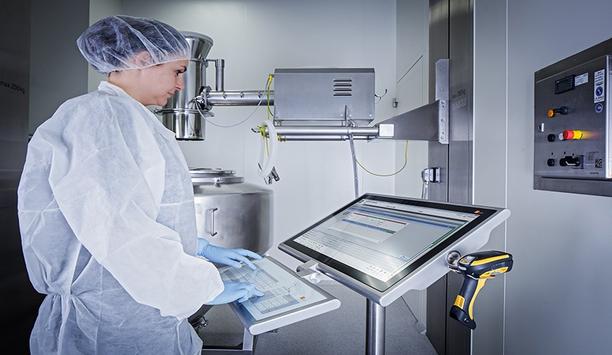
RFID For GMP/GLP Environments
Download
Modernizing Access Control
Download
Enhancing Physical Access Control Using A Self-Service Model
Download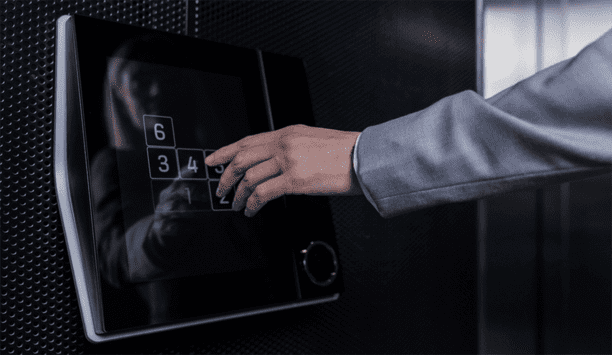
Open Credential Standards And The Impact On Physical Access Control
Download
System Design Considerations To Optimize Physical Access Control
Download
How Biometrics Are Reshaping Security In A Connected World
Download
Palm Vein Recognition
Download
The 2024 State Of Physical Access Trend Report
Download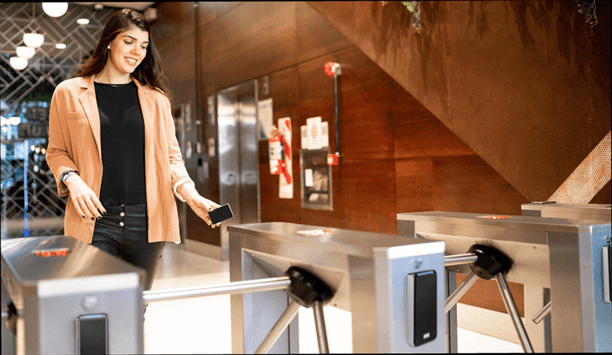
The Truth Behind 9 Mobile Access Myths
Download
Boost Efficiency And Streamline Security With Integrated Access Control
Download
The Top 4 Reasons To Upgrade Physical Security With The Cloud
Download
Access Control: The Enterprise Buyer's Guide
Download
Effectively Branding A Multifamily Property
Download
6 Good Reasons To Embrace Mobile Credentialing
Download

Mobile access: Manufacturers & Suppliers
- CIVINTEC Mobile access
- Honeywell Security Mobile access
- HID Mobile access
- Aiphone Mobile access
- Hikvision Mobile access
- Verkada Mobile access
- ELATEC Mobile access
- AMAG Mobile access
- Senstar Mobile access
- Brivo Systems Mobile access
- Suprema Mobile access
- Software House Mobile access
- ASSA ABLOY Mobile access
